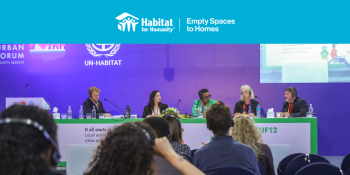
Turning empty spaces into homes
Habitat for Humanity’s Vision for Sustainable Housing at the 2024 World Urban Forum
Europe is facing a troubling situation—while millions struggle with housing insecurity, many buildings remain empty. With 30 million homes in Europe sitting vacant and 900,000 people homeless each night, the need for solutions is urgent. Adding to the crisis, the building sector is responsible for up to 35% of Europe’s energy-related CO₂ emissions. Tackling both the housing shortage and climate concerns requires innovative action.
Ana Carolina Gomes, Associate Director for Strategy and Operations at Habitat for Humanity International, is leading efforts to address this gap. At the World Urban Forum organized by UN-Habitat in November 2024, she outlined Habitat for Humanity’s plan to repurpose vacant buildings—a strategy that combines social impact with environmental responsibility. The goal is to increase affordable housing while also reducing carbon emissions.
A proven model for sustainable housing solutions
Habitat for Humanity’s approach builds on research-backed strategies and demonstration projects that support policy change. The process follows a structured approach:
- research and data collection – gathering reliable data to push for policy changes.
- demonstration projects – refurbishing empty spaces to show practical, scalable solutions.
- stakeholder collaboration – working with governments, industry leaders, and financial institutions to create lasting change.
- advocacy for policy change – engaging with policymakers to integrate sustainable housing solutions into national programs.
This method ensures that solutions are not just theoretical but have been tested in real-world conditions.
From the UK to Poland - Expanding the model
The first version of this model started in the UK, where Habitat for Humanity Great Britain, with help from donors mainly M&G, renovated empty buildings in London. The project successfully turned vacant properties into homes and created toolkits to help local governments implement similar projects.
Next, the project moved to Poland, where the Social Rental Agency model was introduced. Unlike in Western Europe, where rental markets are more structured, Central and Eastern Europe still faces housing systems influenced by the post-Soviet era. With less than 5% of the housing stock being affordable, innovative solutions are needed.
Social Rental Agencies act as intermediaries, connecting private property owners with people in need of affordable housing. This model ensures sustainable housing management while preventing newly refurbished properties from becoming segregated, low-income areas. Instead, a focus on social cohesion promotes diverse tenant communities.
A flagship project
Building on these successes, Habitat for Humanity launched the Empty Spaces to Homes initiative, a flagship program supported by Laudes foundation and M&G, aimed at identifying scalable financial solutions. Through this initiative, several housing units will be renovated to demonstrate cost-effective, climate-friendly ways to repurpose vacant buildings.
Key outcomes of the project include:
- financial innovation – researching market-based funding models to ensure long-term scalability.
- policy advocacy – Working with local and national governments to encourage the reuse of vacant properties.
- carbon impact assessment – measuring CO₂ savings from repurposed buildings to align with EU climate goals.
Advocacy at the EU level
Beyond local efforts, Habitat for Humanity is pushing for EU-wide reforms to make repurposing vacant buildings a central part of Europe’s housing policy. Their advocacy focuses on:
- A unified definition of vacant real estate – standardizing definitions across EU countries for more reliable data.
- Comprehensive mapping of vacant properties – conducting extensive research to identify available spaces.
- Awareness campaigns – promoting the environmental and social benefits of reusing empty properties.
- Strategic EU funding – directing resources from existing programs to speed up the conversion of vacant buildings into affordable homes.
A path forward
As Ana Carolina Gomes emphasizes, solving Europe’s housing crisis requires collective action. Governments, businesses, and civil society must work together to transform empty spaces into homes. By using market-based solutions, building partnerships, and pushing for policy change, Habitat for Humanity is showing that sustainable, affordable housing solutions are possible.
The vision is clear: a future where no home is left empty while people remain without shelter. With the right strategies and collaboration, Europe can close the housing gap and fight climate change—one repurposed building at a time.
Read our manifesto on opportunities for the European Union for 2024-2029.
Also, read the manifesto for Practical Policies for a Just and Resilient Built Environment by the Laudes Foundation Coalition.